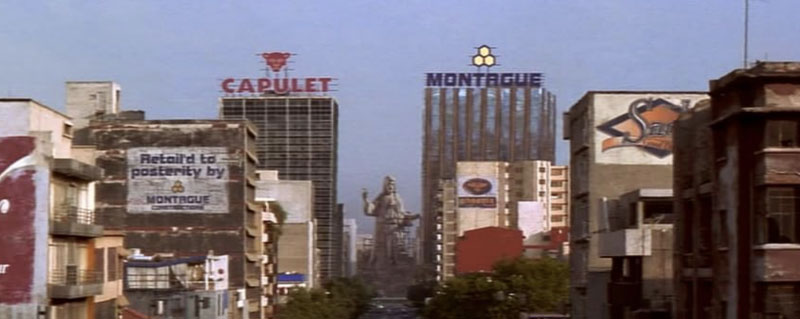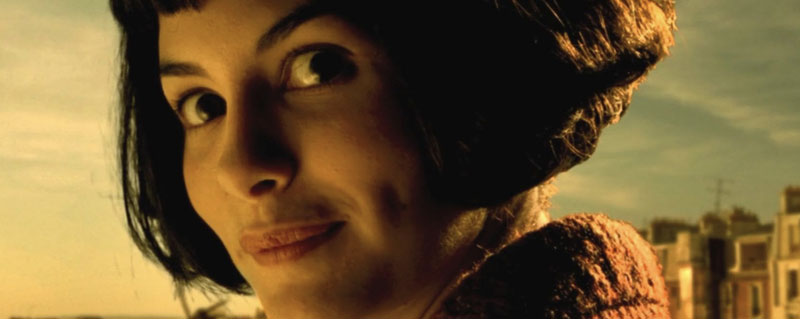There’s a invisible wall between the audience and the story they are watching. Let’s look at the impacts that breaking this fourth wall can have on your film.
Let’s talk, you and I, about how storytelling works. We’ll use some metaphors, I’ll throw in some examples from film, and there might be a digression about pandas or squirrels.
NOTE: I’m lying about the third thing.
But mostly let’s talk about narrative voice in filmmaking, and the ways in which the filmmaker participates in the viewing of the film. Which isn’t to say that I’m sitting next to you in the theater, swiping popcorn from the tub and offering commentary on what we’re watching, because there’s participating and there’s OMG would you let me watch this in peace?

A “story,” by definition, is told to its audience. In the olden days, when film was all shadow puppets and voice-overs, the storyteller was explicitly present in the telling of the story. Over time, as media progressed, the actual story was separated from the act of storytelling, and a variety of narrative styles developed, ranging from a detached viewpoint that showed a series of events, to an omniscient viewpoint that gave us some insight into internal thoughts and processes, to the very close and personal first-person style that harkened back to the oldest style of storytelling. These first-person styles usually include some form of talking directly to the audience.
Historically, theatrical performances took place on a stage bounded on three sides (the backdrop upstage and the wings on the left and right). The remaining side — downstage — was bounded by an invisible wall separating the audience from the performers. The performers carried out their roles in this boxed area, knowing but not acknowledging the presence of the audience beyond this invisible wall. Everyone pretended that the world on stage was, in fact, a world unto itself. The audience’s suspension of disbelief was critical in maintaining the illusion inherent in the performance. This suspension is implicit when we watch a film or a television show. We happily imagine the world in the box is actually larger than it is.

There are times, however, when the performers step outside their characters and speak directly to the audience. In Greek theater, this was typically the role of the Chorus or some other character who provided commentary and narrative for what was unfolding on stage. Shakespeare opens many of his plays with an introduction that sets the stage for the story the audience is about to see. These players rarely participate in the actual narrative, and we can trace a line from these figures to the modern voice-over narrative.
This is commonly known as “breaking the fourth wall.” Some character within the self-contained narrative box is acknowledging our presence by directly interacting with us. Mostly, this breaching of the wall is meant to provide insight into aspects of the narrative that are too complicated and time-consuming to portray on stage (or, in the case of film, would take up too much screen time). You can ground an audience much more quickly by having a voice-over narration explain the set-up for a story. Shakespeare, in four lines — ‘”Two households, both alike in dignity, / In fair Verona, where we lay our scene, / From ancient grudge break to new mutiny, Where civil blood makes civil hands unclean.” — tells you everything you need to know about the relationship between Romeo and Juliet‘s families.

The omniscient narrator is the simplest form of interacting directly with the audience within the confines of the story, and is the purest throwback to the oral traditions. “Gather round, all, and hear this tale I will tell for you.” We understand the rules of this relationship and allow it without losing the magic of the story.
And yet, there are tricks you can do once you’ve set this relationship. Case in point: the narrator in Greta Gerwig‘s blockbusting Barbie provides some useful grounding early in the film and then wanders off, because they aren’t needed once we’re grounded in the story. Until a moment arrives much later in the film when the narrator returns for a single line of voice-over commentary. It’s obtrusive. The film doesn’t pause for it. But it’s a very clever aside that reminds us that we are engaged in a special “out-of-bounds” relationship with the film. Yes, it’s fantastic, and yes, it’s not real, and yes, we might be thinking how this scene doesn’t quite work because we know things the film can’t know, but whatever, the narrator says, you already promised to fully engage with the work, so stick with it!

In this sense, the intrusion of the narrator — this breaching of the fourth wall — deepens our connection with the material. We are invited to more fully engage. In Ferris Bueller’s Day Off, Matthew Broderick‘s character provides the “voice-over” narration by speaking directly to the audience, while in character. This was the genius of John Hughes‘s narrative trick in this film. Ferris knows he’s in a story, knows we were watching his story, and he invites to fully participate with him. It’s not just Ferris’s day off; it’s our day off as well. Without this direct engagement with the audience, the movie is merely the story of a privileged kid who flaunts the system because he can and suffers no consequences.
Alternately, the narrator of Jean-Pierre Jeunet‘s Amélie provides a lot of useful information to assist in the storytelling, but what keeps us engaged is Audrey Tautou‘s persistent awareness of the audience. It’s a fanciful story that requires an extra dose of disbelief, but because Amélie herself invites us to participate, we are willing to take that extra dose. We want to believe in the magic.

And so, this breach of the unspoken contract between audience and narration is a way for a storyteller (or filmmaker) to draw the audience more deeply into the narrative world. We are no longer simple viewers of the story; we are co-participants. The mockumentary style of The Office (both the UK and US version) provides a meta-narrative framework for the show. It’s not just a show about a dysfunctional workplace environment; it’s commentary on every job we’ve ever had. When Jim makes sad eye contact with the camera, we know his pain because, yes, we’re been there ourselves. In breaking the fourth wall, The Office transcends being about them and becomes about us.
Would Michael Scott make an inappropriate workplace joke without us there to see him do it? It’s like that koan about trees and forests and hearing things.

The trick with breaking the fourth wall is knowing how far to go. Do you use it to ground the audience more quickly? Do you use it to create a meta layer to the narrative, a layer which can overwhelm or subvert the story you are telling? Or do you break the wall completely and have characters come out and sit beside the audience and provide commentary on what’s going on, as Ryan Reynolds does in the Deadpool movies?
Wade Wilson, Reynolds’s comic book character in the Deadpool films, knows he’s a fictional character. He (and the filmmaker) knows he is in a movie. He knows an entire world exists outside his (and, in fact, some of the jokes in both films only land because the audience is external to the film). A Deadpool movie isn’t about the narrative of the film so much as they are about the experience of the narrative. They are, frankly, a long anecdote told by someone who can’t stop interrupting themselves with asides and self-referential commentary. Clearly, it works, but it’s a very narrow tightrope to walk.

As a filmmaker, we have to consider how we are going to tell our stories. Are they just a cinematic record where the audience is merely a spectator? Can we intrude upon the audience’s experience without ruining the immersive experience? If we provide a knowing wink (like Bugs Bunny used to do all the time in the cartoons) are we enriching the experience. If the characters know that we’re in on the gag, does the gag work better? And, if we are intrusive, how are we changing the story we’re trying to tell? Breaking the fourth wall can be a useful tool for a filmmaker, but it can also change your project entirely. Choose wisely.
(Cover image from Barbie, courtesy of Warner Bros).
Looking for filmmaking tips and tricks? Check out our YouTube channel for tutorials like this . . .



